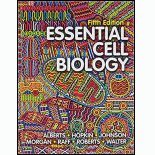
Concept explainers
To calculate: If the DNA were enlarged, so that its diameter equalled to that of an electrical extension cord (5mm), how long would the extension cord be from one end to the other if it is completely stretched out.
Introduction: Deoxyribonucleic acid (DNA) is the genetic material of many eukaryotic organisms composed of two anti-parallel strands of nucleotides linked together by hydrogen bonds existing between the complementary base pairs. It carries all the necessary information required for the growth and development of the organism. The helix exactly looks like a twisted ladder with 10 to 10.5 base pairs in each turn. Length of a definite part of DNA strand primarily depends on the number of sequence it possesses. The building blocks of DNA, nucleotides are stacked in the helix at an interval of 0.4nm, and the diameter of the strand is about of 2nm.
To calculate: If the DNA were enlarged, so that its diameter equalled to that of an electrical extension cord of length 5mm, how close would the bases be to each other.
Introduction: Deoxyribonucleic acid (DNA) is the genetic material of many eukaryotic organisms composed of two anti-parallel strands of nucleotides linked together by hydrogen bonds existing between the complementary base pairs. It carries all the necessary information required for the growth and development of the organism. The helix exactly looks like a twisted ladder with 10 to 10.5 base pairs in each turn. Length of a definite part of DNA strand primarily depends on the number of sequence it possesses. The building blocks of DNA, nucleotides are stacked in the helix at an interval of 0.4nm, and the diameter of the strand is about of 2nm.
To calculate: If the DNA is enlarged, so that its diameter equalled to that of an electrical cord from one end to the other, how long would a gene of 1000
Introduction: Deoxyribonucleic acid (DNA) is the genetic material of many eukaryotic organisms composed of two anti-parallel strands of nucleotides linked together by hydrogen bonds existing between the complementary base pairs. It carries all the necessary information required for the growth and development of the organism. The helix exactly looks like a twisted ladder with 10 to 10.5 base pairs in each turn. Length of a definite part of DNA strand primarily depends on the number of sequence it possesses. The building blocks of DNA, nucleotides are stacked in the helix at an interval of 0.4nm, and the diameter of the strand is about of 2nm.
Want to see the full answer?
Check out a sample textbook solution
Chapter 5 Solutions
Essential Cell Biology 5e
- In one paragraph show how atoms and they're structure are related to the structure of dna and proteins. Talk about what atoms are. what they're made of, why chemical bonding is important to DNA?arrow_forwardWhat are the structure and properties of atoms and chemical bonds (especially how they relate to DNA and proteins).arrow_forwardThe Sentinel Cell: Nature’s Answer to Cancer?arrow_forward
- Molecular Biology Question You are working to characterize a novel protein in mice. Analysis shows that high levels of the primary transcript that codes for this protein are found in tissue from the brain, muscle, liver, and pancreas. However, an antibody that recognizes the C-terminal portion of the protein indicates that the protein is present in brain, muscle, and liver, but not in the pancreas. What is the most likely explanation for this result?arrow_forwardMolecular Biology Explain/discuss how “slow stop” and “quick/fast stop” mutants wereused to identify different protein involved in DNA replication in E. coli.arrow_forwardMolecular Biology Question A gene that codes for a protein was removed from a eukaryotic cell and inserted into a prokaryotic cell. Although the gene was successfully transcribed and translated, it produced a different protein than it produced in the eukaryotic cell. What is the most likely explanation?arrow_forward
- Molecular Biology LIST three characteristics of origins of replicationarrow_forwardMolecular Biology Question Please help. Thank you For E coli DNA polymerase III, give the structure and function of the b-clamp sub-complex. Describe how the structure of this sub-complex is important for it’s function.arrow_forwardMolecular Biology LIST three characteristics of DNA Polymerasesarrow_forward
 Human Anatomy & Physiology (11th Edition)BiologyISBN:9780134580999Author:Elaine N. Marieb, Katja N. HoehnPublisher:PEARSON
Human Anatomy & Physiology (11th Edition)BiologyISBN:9780134580999Author:Elaine N. Marieb, Katja N. HoehnPublisher:PEARSON Biology 2eBiologyISBN:9781947172517Author:Matthew Douglas, Jung Choi, Mary Ann ClarkPublisher:OpenStax
Biology 2eBiologyISBN:9781947172517Author:Matthew Douglas, Jung Choi, Mary Ann ClarkPublisher:OpenStax Anatomy & PhysiologyBiologyISBN:9781259398629Author:McKinley, Michael P., O'loughlin, Valerie Dean, Bidle, Theresa StouterPublisher:Mcgraw Hill Education,
Anatomy & PhysiologyBiologyISBN:9781259398629Author:McKinley, Michael P., O'loughlin, Valerie Dean, Bidle, Theresa StouterPublisher:Mcgraw Hill Education, Molecular Biology of the Cell (Sixth Edition)BiologyISBN:9780815344322Author:Bruce Alberts, Alexander D. Johnson, Julian Lewis, David Morgan, Martin Raff, Keith Roberts, Peter WalterPublisher:W. W. Norton & Company
Molecular Biology of the Cell (Sixth Edition)BiologyISBN:9780815344322Author:Bruce Alberts, Alexander D. Johnson, Julian Lewis, David Morgan, Martin Raff, Keith Roberts, Peter WalterPublisher:W. W. Norton & Company Laboratory Manual For Human Anatomy & PhysiologyBiologyISBN:9781260159363Author:Martin, Terry R., Prentice-craver, CynthiaPublisher:McGraw-Hill Publishing Co.
Laboratory Manual For Human Anatomy & PhysiologyBiologyISBN:9781260159363Author:Martin, Terry R., Prentice-craver, CynthiaPublisher:McGraw-Hill Publishing Co. Inquiry Into Life (16th Edition)BiologyISBN:9781260231700Author:Sylvia S. Mader, Michael WindelspechtPublisher:McGraw Hill Education
Inquiry Into Life (16th Edition)BiologyISBN:9781260231700Author:Sylvia S. Mader, Michael WindelspechtPublisher:McGraw Hill Education





